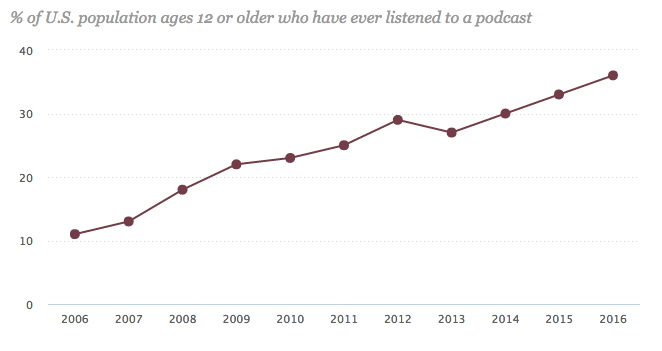Reaching all students on (and off) campus can sometimes feel like a mystery.
Student affairs professionals and students are starting podcasts to apply student engagement theory to audio listening.
With various options in traditional marketing and new social media trends we’re constantly educating ourselves on the newest trends to engage students.
Audio content delivered and marketed to students is becoming a clever and creative way to capture students’ individual attention.
We already explored the power of student voices, and this post builds upon that by putting the philosophy into action by not just making podcasts for students, but with students.
And we believe creating and delivering relevant, meaningful podcasts is a trend here to stay.
Why Podcast?
Podcasts have been on the upswing in popularity in the past few years.
They’re grounded in relative obscure topics to mainstream news, covering subject areas from all over the world. Podcasts range from politics, to TV show recaps, sports, comedy, and even higher education.
In an era of on-demand everything, podcasts provide entertainment because we can now learn about anything we want, often while performing other activities.
According to the Pew Research Center, the percentage of people in the U.S. listening to podcasts have increased since 2013.

About one-third of Americans have now listened to podcasts, with that trend continuing to be on the rise. That’s an estimated 98 million people in 2016 according to Edison Research.
Typically, people listen to podcasts via headphones on commutes, working out, or doing other tasks making it a solitary activity. For these reasons, podcasts offer an intimate connection to an audience. The discussions really resonate with listeners.
Podcasting is another way to attract unconventional student leaders. You can listen to them almost anywhere. After all, the medium of podcasting allows for open, niche focused long-form conversations that you can’t find anywhere else.
Preparing to Podcast
In thinking about both popularity and how this medium is focused on audio rather than visual, we thought we’d outline tips for you to set up your first podcast. It can be intimidating at first (who wants to listen to their own voice?) but if you have the passion and drive to make it happen, we’re happy to help you get a kick start.
Let’s dive in! ?
Step 1: Determining Topics
Brainstorm ideas with students and determine what topics the podcasts should entail prior to launching your podcast.
Some ideas include: campus life news, moments with campus leadership, dining hall staff, residence life, student leaders from specific student organizations, highlighting and recapping student events, politics, or random, fun yet meaningful topics that may seem unconventional. Brainstorming a wide variety of topics will create a larger net at first and will help you narrow down at a later date.
Remember, it’s okay to experiment and take a good look at what’s working well and what’s not in the beginning stages of podcasting. It doesn’t have to be perfect the first time around- there’s always room to improve and iterate!
Step 2: Finding Podcasts to Learn From
One of the best ways to understand what you want in your own podcast is to listen to others. This will help you determine what you like, what you don’t like, and what might work best for your audience (students).
Podcasts that we’ve listened to and recommend starting with include:
Changing Our Campus Culture Podcast is a great example of an educational podcast that could be used a great template for your office to do some unique outreach to students.
Buffer’s Science of Social Media Podcast helps to learn about social media techniques and specific outreach to audiences on social media. Maybe you need help reaching more off-campus students or want to provide direct outreach to parents. They have some great tips on providing unique content via social media.
The Student Affairs Spectacular Podcast by the Student Affairs Collective discusses higher ed trends and topics to connect listeners with student affairs professionals all over the country. This is a great way to expand professional development for free.
Josie and the Podcast is run by Dr. Josie Ahlquist who speaks with digital leaders and aims to bring new resources through individual conversations. Although new, Josie has a unique guest line-up that student affairs professionals should look out for! ?
There’s also some great research about how to use podcasts in the classroom and how professors can benefit from incorporating different mediums to engage various learning styles.
Ask your students what type of podcasts they enjoy listening to and ask them to brainstorm what types of content you might be missing. This is one of the best ways to get to the heart of the type of content students may be searching for.
Step 3: Asking Students to Host
The host can make or break a podcast. The host is the facilitator and is key to asking great questions, pulling out unique insights, and making the audio content relatable to the audience listening.
We know students influence students the most and they tend to trust other student opinions, so before taking the reigns (of yet another project), consider giving students full reigns in organizing and hosting to see what they come up with.
Every once in awhile, consider a guest host (advisor, professor, or another campus figure) and evaluate how that may impact the engagement of the podcast.
Step 4: Finding Guests to Interview
You have a major opportunity to get students to listen to campus leaders they may not otherwise hear from. Utilizing a podcast medium to hear from leaders is a great way to build campus culture and address student concerns and celebrations.
Individuals you may want to consider on a podcast include:
- Campus President, Vice President for Student Affairs, or Dean of Students
- Club and organization student leaders
- Club and organization advisors
- Professors/faculty
- Dining hall representatives
- Maintenance crew or janitorial staff
- Institutional alumni
Think of student and staff influencers who offer unique insight and can create more value for your podcast. Give students multiple reasons to tune in, listen, and an opportunity to think deeply about on-campus resources, opportunities, and people!
Step 5: Outlining the Podcast
We actually found a podcast on how to best outline a podcast (meta, we know).
Check out, “Using Great Outlines to Keep Your Listener’s Attention” by Aaron Dowd aka The Podcast Dude.
Additionally, we found an example outline from voices.com that offers a great visual outline to consider for your team organizing the podcast:
Show intro monologue (who you are, what you’re going to talk about): 30-60 seconds
Intro music jingle (repeat for each show so listeners identify the jingle with your show): 30-60 seconds
Topic 1: 3 minutes
Topic 2: 3 minutes
Interlude (music or break): 30 seconds
Topic 3: 3 minutes
Topic 4: 3 minutes
Closing remarks (thank audience, thank guests, talk about the next show): 2 minutes
Closing music jingle (suggest same as Intro music jingle): 2 minutes
Step 6: Recording the Podcast
Depending on your budget, you can technically do a podcast for free, but the more you invest in software, tools, and technology the higher quality the end product will be.
This isn’t the top to-do to worry about, but it is an important one since people need to be able to hear you talking and find your podcast. After reviewing multiple guides and processes online, we realize there’s no ‘perfect’ way to podcast. Especially since your own podcast processes will be determined by budget, campus stakeholders, and time you can put aside for this student engagement project.
Here are some high quality tools & tips to consider when recording your podcast:
- After testing out your microphone, determine if you need a professional microphone that will create a high quality recording.
- If you’re chatting with someone from afar, consider utilizing an application called Skype (as a calling method) and utilize the software Ecamm (Mac users) or VodBurner (PC users), both run $15-$30, which allows you to video or audio recorder for Skype. This way, you’ll be able to record your conversation stress-free ?
- If you’re recording in-person, utilize a microphone in a silent room that won’t pick up on background noise.
- Most people use headphones despite being in a quiet room. Sometimes computers like to produce an echo. It’s best to create a test segment to make sure you’re eliminating an echo and providing your audience with a clear recording.
- Edit your podcast with software like Garageband (Mac users) or Audacity (PC users).
Step 7: Creating Community
Of course, there would be no podcast without a community to listen!
The ultimate goal of creating a podcast is to reinforce your student engagement strategy and help students feel like they belong. Use social media platforms, e-mail, and word-of-mouth to get the word out about your new initiative.
Podcasting reaches a new community of students that may not have been engaged previously. Expect celebrations and constructive feedback in this new venture. Listening to your existing (and new) community and continuously improving makes your community stronger and will ensure you’re creating the best audio content for students.
Your Thoughts!
We wish you the best in starting your own student engagement podcast.
We’d love to hear your advice, lessons you’ve learned through podcasting, how to make the most of them, and anything we might have missed!
Tweet us at @HigherEd_Geek, @kayleyrobsham, or @CheckImHere!
Cheers! ?





